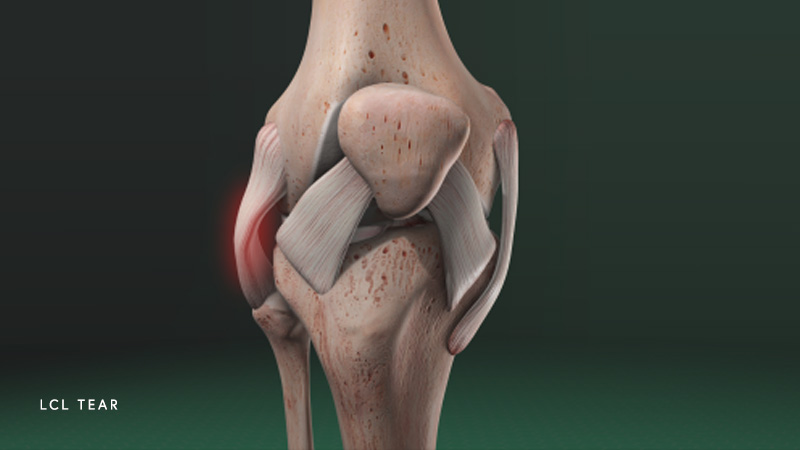LCL Tear
The Lateral Collateral Ligament (LCL) is a vital part of the normal functionality of the knee. An injury to the LCL could cause many symptoms and ultimately a lot of pain.
The knee consists of four bones: femur(thigh), tibia (leg), fibula (leg), and patella (kneecap), and four major ligaments: ACL, PCL, MCL and LCL. The two ligaments in the middle of the knee cross each other and are therefore known as the cruciates. On the inner, or medial side is the Medial Collateral Ligament (MCL) and on the outer, or lateral side, the Lateral Collateral Ligament (LCL). Between the femur and tibia are the meniscal cartilages, medial meniscus on the inner side, and lateral meniscus on the outer side. The quadriceps muscle, in front, attaches, by the quadriceps tendon, to the patella, which, in turn attaches by the patella tendon, to the tibia. When working properly, the quadriceps mechanism can straighten the knee and provide kicking power. The hamstring muscles attach to the fibula and the back of the tibia to help to power bending the knee.
An LCL tear occurs when the knee bends inwards excessively or quickly and strenuously. This results in the LCL stretching too far which can lead to the LCL tearing or rupturing. LCL tears are graded on a scale of one to three in their severity, as are other ligament tears.
Grade 1 LCL Tear
A grade one tear is an incomplete tear of the LCL. The ligament itself is still intact and functional, and the symptoms usually pale in comparison to a grade two or grade three tear. Patients usually feel minimal pain when pressure is applied to the LCL in this stage. Most athletes may return to their sports in a few weeks after rest.
Grade 2 LCL Tear
A grade two tear is also considered an incomplete tear of the LCL. Most patients with a grade 2 LCL tear feel a high level of instability or pain when attempting to pivot and cut right or left. With this grade of tear, pain and swelling are experienced on significantly higher scales than a grade one tear. Usually a month or more of rest is required before returning to daily activities, recreational activities, or sports.
Grade 3 LCL Tear
A grade three tear is a complete rupture or tear of the LCL. Patients with this grade of tear experience sharp excruciating pain and large amounts of swelling on the outside of their knee. Knee instability (when the knee regularly gives out when attempting to bear weight on it) is often associated with a grade three tear. Grade three tears normally require surgical reconstruction.

LCL tears often occur to those playing sports that require quick pivoting and cutting while applying high amounts of pressure to the hinge joint of the knee. Excessive bending with applied force can also cause an LCL tear. Those who play sports such as football or hockey are more likely to experience forceful collisions and tear their LCL. The LCL can also be injured in car accidents, where extreme pressure is applied to the LCL. The LCL may also tear in conjunction with another knee injury.
Common symptoms experienced with an LCL tear may include the following:
- Knee instability
- Sharp pain on the outside of the knee
- Dull pain on the outside of the knee
- Swelling
- Limited range of motion
- Pain when bending or extending the leg
- Bruising
During a physical exam, the physician will test the knee for tenderness, pain, and swelling. The physician will also move the knee and test its range of motion while asking if there is any pain associated with the motions. The physician may also ask that the patient walk for them to see if there is any pain or abnormalities in the walking. If a diagnosis cannot be made, the physician will normally order for imaging to rule out other possible conditions. XRays will reveal whether or not there are any broken bones. MRIs and CT scans will reveal the current state of the ligaments in the knee to determine the location of the injury and its grade (severity).
Treating an LCL is dependent on the grade of the tear. Grade one and two tears are most commonly treated with the R.I.C.E. method. This acronym stands for rest, ice, compression, and elevation of the affected area. Continuing the R.I.C.E. method for the course of one month has proven to heal grade one and two LCL tears. Anti-inflammatory drugs also may help control swelling and prevent inflammation in a grade one or two tear. On occasion, physical therapy may be required to strengthen the knee joint and prevent future tears.
Grade three tears typically require surgery in order to repair or reconstruct the ligament. When the LCL is torn at the attachment to the bone, a surgical repair may be a possibility. However, if the LCL is torn at the center of the ligament, a reconstruction procedure is often required. Tissue from elsewhere in the body, or from a donor, is used to create a new LCL during this type of surgery.
If you or a loved one are currently experiencing knee instability or pain, contact the professionals at the Center for Orthopaedic Specialists. The Center for Orthopaedic Specialists have been providing Ventura County and Los Angeles residents with the treatment they need for ligament tears for many years. Contact us today!




 / 50 Reviews
/ 50 Reviews